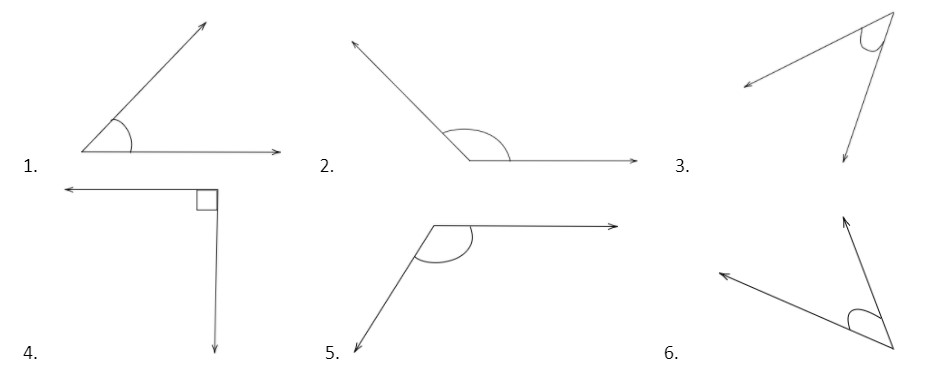
Identify the acute angles, right angle and acute angle from the following.


Answer
498.3k+ views
Hint:The basic definitions of acute angle, right angle and obtuse angle area based on the comparison with the right angles. The notations used to show the angles at the vertex are also trivial; observe the notations shown in each figure carefully. Note that we can’t measure the angle by just looking at it.
Complete step-by-step answer:
First observe each figure correctly. The right-angle measures
The angle which measures less than
The angle which measures greater than
We will start from figure 1. The first angle is less than the
Now observe the figure 2. The second figure is greater than
Similarly, the figure 3. The figure follows the line of figure 1 and it is an angle less than
The fourth figure is clearly a right angle as it has a square drawn to its vertex.
The figure number 5 follows the path of the second figure and it has an angle greater than
The last figure is the same as the third figure but in the different direction. Thus, it is also an angle less than
Thus, in the given figures, figure 1, 3, 6 are acute angles, figures 2 and 5 are obtuse angles while the 4th figure is a right angle.
Note:Observation should be very keen in this case. There are different angles with different directions so don’t confuse yourself with the directions of the angle. Compare every angle with the right angle so that it will be easier to differentiate each angle with the right angle.
Complete step-by-step answer:
First observe each figure correctly. The right-angle measures
The angle which measures less than
The angle which measures greater than
We will start from figure 1. The first angle is less than the
Now observe the figure 2. The second figure is greater than
Similarly, the figure 3. The figure follows the line of figure 1 and it is an angle less than
The fourth figure is clearly a right angle as it has a square drawn to its vertex.
The figure number 5 follows the path of the second figure and it has an angle greater than
The last figure is the same as the third figure but in the different direction. Thus, it is also an angle less than
Thus, in the given figures, figure 1, 3, 6 are acute angles, figures 2 and 5 are obtuse angles while the 4th figure is a right angle.
Note:Observation should be very keen in this case. There are different angles with different directions so don’t confuse yourself with the directions of the angle. Compare every angle with the right angle so that it will be easier to differentiate each angle with the right angle.
Recently Updated Pages
Basicity of sulphurous acid and sulphuric acid are

Master Class 12 Economics: Engaging Questions & Answers for Success

Master Class 12 Maths: Engaging Questions & Answers for Success

Master Class 12 Biology: Engaging Questions & Answers for Success

Master Class 12 Physics: Engaging Questions & Answers for Success

Master Class 4 Maths: Engaging Questions & Answers for Success

Trending doubts
Give 10 examples for herbs , shrubs , climbers , creepers

How many millions make a billion class 6 maths CBSE

Number of Prime between 1 to 100 is class 6 maths CBSE

Four bells toll together at 900am They toll after 7811 class 6 maths CBSE

Name the countries which are larger than India class 6 social science CBSE

1 lakh Thousand class 6 maths CBSE





